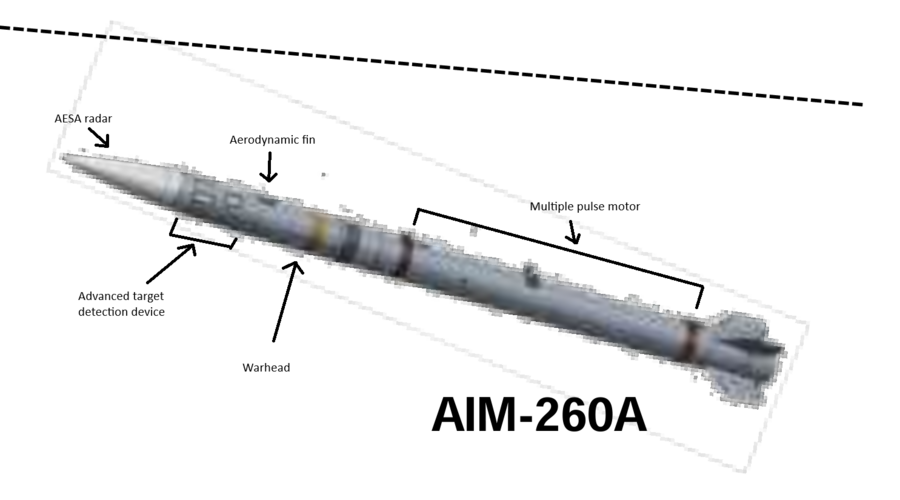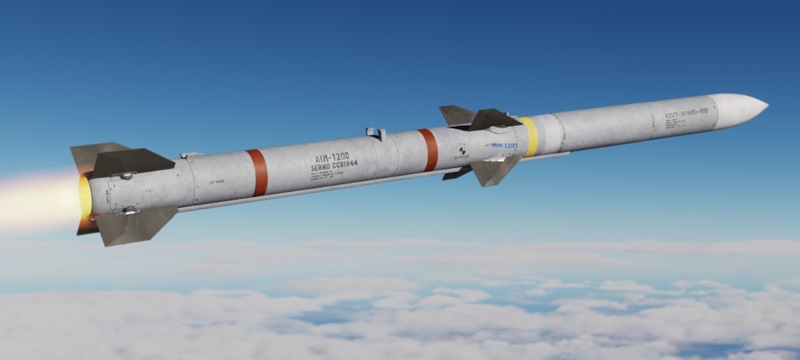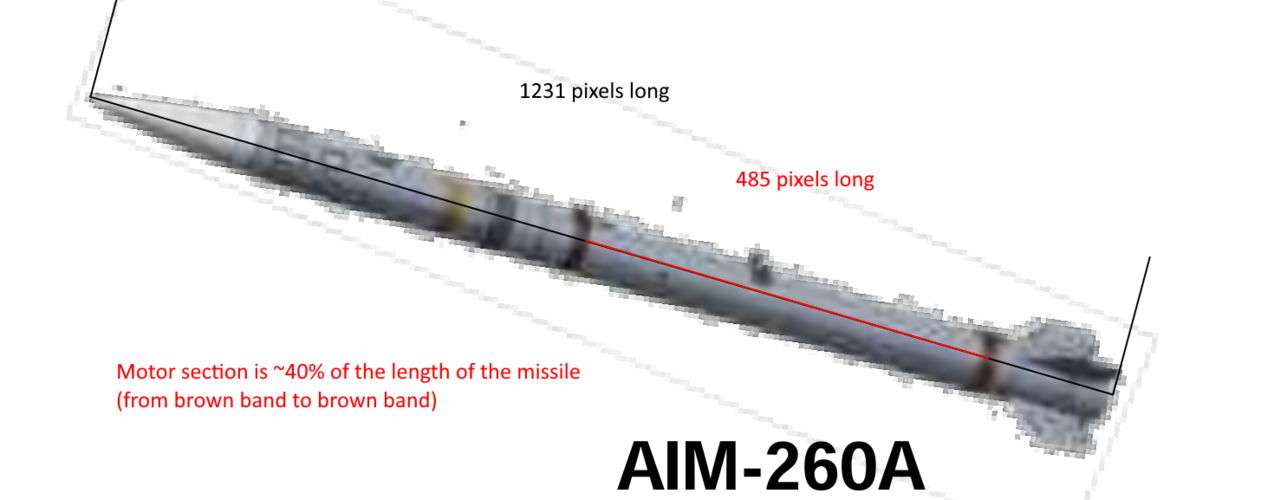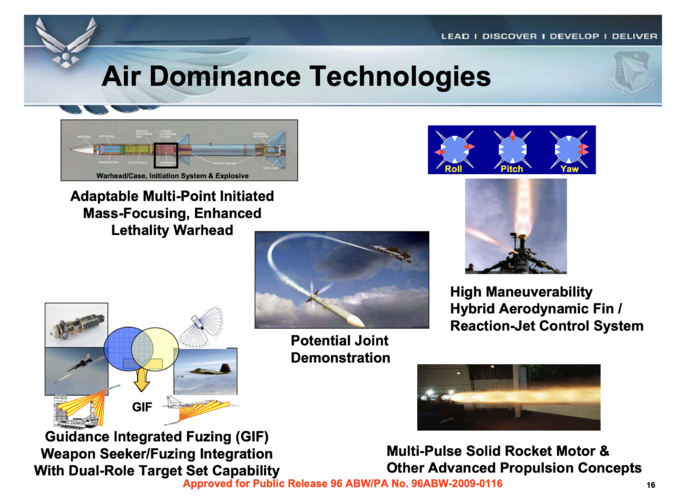It looks like a small PL-17, hard to image it can have comparable agility with AIM-174 and R-37It doesn't omit aerodynamic features near the middle entirely.
You are using an out of date browser. It may not display this or other websites correctly.
You should upgrade or use an alternative browser.
You should upgrade or use an alternative browser.
Lockheed Martin AIM-260 Joint Advanced Tactical Missile (JATM)
- Thread starter Jeb
- Start date
Or may be the range is. 10% better than AIM-120D but it has AESA seekerSo swapping small forward fins for tiny ones doubles the range. . .how?
How did the AIM-7F improve the range of the Sparrow over the earlier AIM-7E?So swapping small forward fins for tiny ones doubles the range. . .how?
A revision to the electronics, placement of modules, and the reduction in overall space required for these parts allows for a much larger motor section and enhanced aerodynamic features.
Modern high performance wingless missiles tend to be far more maneuverable than those which were developed in the 80s.It looks like a small PL-17, hard to image it can have comparable agility with AIM-174 and R-37
In most case, it is due to TVC or mid body gas thruster. But at high altitude and at BVR, tbh, it hard to imagine anything replace lifting surfaceModern high performance wingless missiles tend to be far more maneuverable than those which were developed in the 80s.
bring_it_on
I really should change my personal text
- Joined
- 4 July 2013
- Messages
- 3,653
- Reaction score
- 3,787
Or maybe the range is 74% better than AIM-120D and it has a AESA seeker.Or may be the range is. 10% better than AIM-120D but it has AESA seeker
Maximum range can double on the AIM-120 simply as a function of massively increased battery and unusable ballistic trajectory. What is more important than "doubling the range" is doubling the NEZ.Or maybe the range is 74% better than AIM-120D and it has a AESA seeker.
I don't think it uses either to be honest.In most case, it is due to TVC or mid body gas thruster. But at high altitude and at BVR, tbh, it hard to imagine anything replace lifting surface
Didn’t Raytheon said latest version of AIM-120D approach the range requirement of AIM-260Or maybe the range is 74% better than AIM-120D and it has a AESA seeker.
The latest version of Raytheon’s AIM-120 Advanced Medium Range Air-to-Air Missile is approaching the “threshold” range required of the new and secretive AIM-260 Joint Advanced Tactical Missile, a company executive said Sept. 10

Raytheon: AMRAAM, JATM ‘Complementary’ in Future Force Mix
The Air Force should use the JATM dogfight missile as a complement to the AMRAAM, a Raytheon executive said.
Same. That why I feel like it will be less agile compared to R-37 and AIM-174 at high altitude.I don't think it uses either to be honest.
bring_it_on
I really should change my personal text
- Joined
- 4 July 2013
- Messages
- 3,653
- Reaction score
- 3,787
Didn’t Raytheon said latest version of AIM-120D approach the range requirement of AIM-260
Raytheon execs carefully worded the statement to compare to the program's threshold requirement. If the AIM-120D is such a competitive weapon, vis-a-vis JATM, how come Raytheon is not building the JATM despite being a very strong (25K+ missiles delivered) incumbent?
Maximum range can double on the AIM-120 simply as a function of massively increased battery and unusable ballistic trajectory. What is more important than "doubling the range" is doubling the NEZ.
Yes, correct. Performance gains over AMRAAM can come via a whole host of factors. Including as you point, more propellent..I was just adding my 2 cents to the "let us make up a range % increase" game.
- Joined
- 3 June 2011
- Messages
- 18,330
- Reaction score
- 12,202
Given how small modern electronics are, I'd think you could take the motor all the way to the yellow stripe on the "AIM-260A", especially if it's hit-to-kill.Based on questionable measurement methods the AIM-260 has considerably more % of the length of the missile going towards motor than the early AMRAAM.
bring_it_on
I really should change my personal text
- Joined
- 4 July 2013
- Messages
- 3,653
- Reaction score
- 3,787
Somewhere in the 41 - 44% or roughly 5.2 feet assuming a 12 ft. long missile and this is even a correct characterization of the missile.Based on questionable measurement methods the AIM-260 has considerably more % of the length of the missile going towards motor than the early AMRAAM.
That's what LM showed on the CUDA..something like 55+% of the length was RM IIRC.Given how small modern electronics are, I'd think you could take the motor all the way to the yellow stripe on the "AIM-260A", especially if it's hit-to-kill.
Last edited:
How much is the equivalent motor length for the AIM-120D? Perhaps that way one can have a rough range estimate based on the ratio.Somewhere in the 41 - 44% or roughly 5.2 feet assuming a 12 ft. long missile and this is even a correct characterization of the missile.
bring_it_on
I really should change my personal text
- Joined
- 4 July 2013
- Messages
- 3,653
- Reaction score
- 3,787
How much is the equivalent motor length for the AIM-120D? Perhaps that way one can have a rough range estimate based on the ratio.
Based on my very rough calculations around 25-27% (bands).
Last edited:
Isn’t the motor section on AIM-120 longer than the outter brown band?The picture shows the usual colored bands which can now be used to compare to AIM-120. We know the two are the same diameter, so we can start there.
One can immediately note the motor section takes up considerably more than it did on the AIM-120.
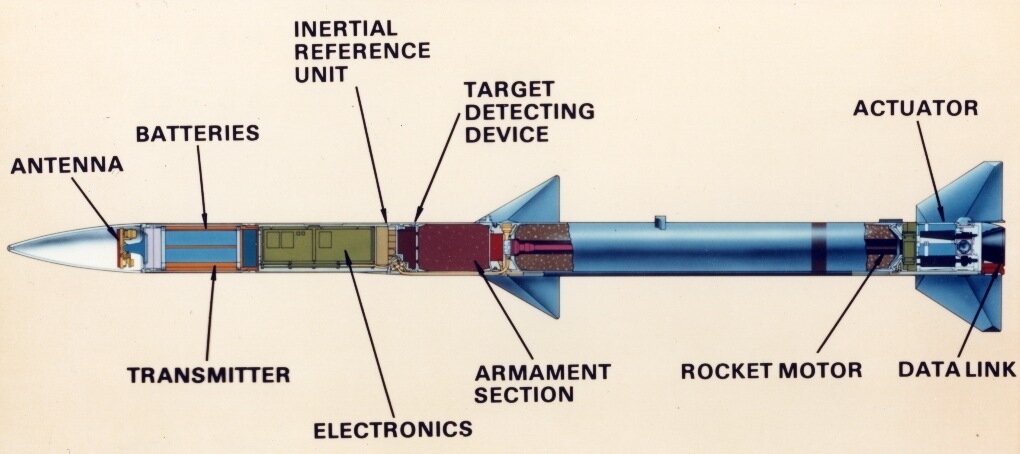
It wouldn't need such a target detection device if it was primarily hit to kill.Given how small modern electronics are, I'd think you could take the motor all the way to the yellow stripe on the "AIM-260A", especially if it's hit-to-kill.
The same could potentially be said for AIM-260 thoIsn’t the motor section on AIM-120 longer than the outter brown band?
No ideaSeem like the motor length is somewhat comparable to Meteor?
Scott Kenny
ACCESS: USAP
- Joined
- 15 May 2023
- Messages
- 11,553
- Reaction score
- 14,169
Keyword there is Threshold.Raytheon execs carefully worded the statement to compare to the program's threshold requirement. If the AIM-120D is such a competitive weapon, vis-a-vis JATM, how come Raytheon is not building the JATM despite being a very strong (25K+ missiles delivered) incumbent?
Looking at other programs talking about a generational/massive increase in capability, the Threshold number seems to be half to two-thirds of the goal numbers. "You must be at least this tall to ride" or rather, even be considered for competition.
And the Delta 7 only almost reaches the threshold number.
With those tiny forward fins it almost makes me wonder if they're pulling some interesting stuff with aerodynamics to steer the airflow so that they get a lot more lift than you'd expect.The picture shows the usual colored bands which can now be used to compare to AIM-120. We know the two are the same diameter, so we can start there.
View attachment 760536
Scott Kenny
ACCESS: USAP
- Joined
- 15 May 2023
- Messages
- 11,553
- Reaction score
- 14,169
As rough as that image is, I'm not sure there's any fins up front at all.With those tiny forward fins it almost makes me wonder if they're pulling some interesting stuff with aerodynamics to steer the airflow so that they get a lot more lift than you'd expect.
Some kind of effector? EM?With those tiny forward fins it almost makes me wonder if they're pulling some interesting stuff with aerodynamics to steer the airflow so that they get a lot more lift than you'd expect.
A few pages ago Shusui claimed to have actually seen the JATM a while ago, and everything he claimed back then lines up with what we're now seeing.As rough as that image is, I'm not sure there's any fins up front at all.
If he says that there's tiny fins there I'm at least willing to entertain the notion.
I was more thinking about creating turbulence above the missile body that would generate lift.Some kind of effector? EM?
bring_it_on
I really should change my personal text
- Joined
- 4 July 2013
- Messages
- 3,653
- Reaction score
- 3,787
Isn’t the motor section on AIM-120 longer than the outter brown band?
It is. Even if you go full 50 inches for the motor (casing dimensions) you are still looking at a significantly greater length on the graphic for JATM even if you stay within the bands. I'm getting something between 62-70 (5+ ft to 6 ft) inch SRM vs 50 inch for AMRAAM. That is a significant volume gain for greater range even if you set aside the pulsed motor that JATM is expected to be using. This obviously assumes the graphic is accurate enough to actually draw those inferences which is far from certain.
I don't think it uses either to be honest.
AFRL had been playing around with a number of options for its future missiles. Aim being agility especially HOBS etc so that the weapon can be more effectively used across a range of scenarios.
Attachments
Last edited:
Heatloss
ACCESS: Confidential
- Joined
- 23 December 2023
- Messages
- 68
- Reaction score
- 182
I'm waiting until we see a real picture to call it for sure, but that looks like a 7" airframe, not an 8".I wonder if it has an 8" diameter airframe like the AIM-7?
FighterJock
ACCESS: Above Top Secret
- Joined
- 29 October 2007
- Messages
- 5,597
- Reaction score
- 5,923
Same here Heatloss, all this speculating is just annoying right now, why bother.
It was already confirmed AMRAAM replacement in AMRAAM form factor, it's 7" not 8. That part shouldn't be speculation and now y'all see the general shape I made in paint was pretty much spot on.Same here Heatloss, all this speculating is just annoying right now, why bother.
Forest Green
ACCESS: Above Top Secret
- Joined
- 11 June 2019
- Messages
- 9,473
- Reaction score
- 17,285
The design without the front fins dates back a fair bit.
View: https://x.com/AirPowerNEW1/status/1893612586358198474
View: https://x.com/AirPowerNEW1/status/1893612586358198474
8245xiaoyao
ACCESS: Restricted
- Joined
- 11 July 2024
- Messages
- 1
- Reaction score
- 1
About the "Advanced target detection device",my guess
1.Multiple fusion IR seeker,the reason is LM has already use this tech on THAAD and MAKO,it meas JATM may have very high mach number or it can be used as an missile interceptor
2.RF seeker,to provide large scanning FOV,maybe JATM‘s range is too far so it has to depend on itself to find the target(LOAL capability maybe)
3.Phased array antenna for advanced high speed datalink(Something like MADL?or just direct connect with the Link 16 or AMTI satellites)
4.Just some Advanced fuzes to control the warhead....
1.Multiple fusion IR seeker,the reason is LM has already use this tech on THAAD and MAKO,it meas JATM may have very high mach number or it can be used as an missile interceptor
2.RF seeker,to provide large scanning FOV,maybe JATM‘s range is too far so it has to depend on itself to find the target(LOAL capability maybe)
3.Phased array antenna for advanced high speed datalink(Something like MADL?or just direct connect with the Link 16 or AMTI satellites)
4.Just some Advanced fuzes to control the warhead....
- Joined
- 30 May 2023
- Messages
- 127
- Reaction score
- 225
Shusui those ports or marks you mentioned near the front of JATM - you reckon they are sensors or attitude control related?
Last edited:
- Joined
- 3 June 2011
- Messages
- 18,330
- Reaction score
- 12,202
You still need to be able to detect the target if you're hit-to-kill.It wouldn't need such a target detection device if it was primarily hit to kill.
The same could potentially be said for AIM-260 tho
No idea
- Joined
- 11 February 2007
- Messages
- 2,545
- Reaction score
- 4,333
Surely at high altitude aerodynamic agility declines due to reduced air density, while TVC and gas thrusters should maintain or increase their effectiveness?In most case, it is due to TVC or mid body gas thruster. But at high altitude and at BVR, tbh, it hard to imagine anything replace lifting surface
bring_it_on
I really should change my personal text
- Joined
- 4 July 2013
- Messages
- 3,653
- Reaction score
- 3,787
I think it could be some sort of secondary terminal guidance with integrated fuzing mechanism and smart aimpoint selection. If they have gone down the path of a LE or focused warhead solution, you would certainly need those things to ensure lethality, particularly against low observable and in a complex ECM environment.You still need to be able to detect the target if you're hit-to-kill.
Last edited:
Nothing announced. The Adrianos technology used an Al-Li alloy in the SRM propellant rather than pure aluminum. Theoretically, it gives you about a 10% increase in impulse. It would help performance, but it wasn’t game changing for tactical application. Most AAMs use reduced-smoke or min-smoke propellants which contain very little or no aluminum in the formulation.Energetic breakthroughs announced anywhere? Adranos purchased by Andruril was testing some proprietary solid rocket blend with 30%, IIRC, improvement in range/volume or something like that.
I think it is simply a case (hah!) of more propellant and a second high thrust pulse to increase end game lethality. The absolute range might not be dramatically different from the latest AIM-120, but the envelope against high performance targets might be night and day. Improved seeker/target detection as well, though I expect it still has a warhead or minimally a “lethality enhancer”, which IMO is just a low HE prefragmented warhead by another name.
bring_it_on
I really should change my personal text
- Joined
- 4 July 2013
- Messages
- 3,653
- Reaction score
- 3,787
Air Force has invested in both small LE warhead development, and mass focusing LE warhead research. Both with an eye on weight optimization while retaining or increasing lethality against targets. It remains to be seen which, if any, of that area of focus made it into the JATM design. An application of a LE warheads on JATM may be very different than what was achieved on say the PAC-3 program.“lethality enhancer”, which IMO is just a low HE prefragmented warhead by another name.
Last edited:
- Joined
- 11 February 2010
- Messages
- 1,648
- Reaction score
- 2,696
I'm more curious on the seeker department. AESA seeker might means strapdown, this demand high bandwidth autopilot, the missile will need to be "sensitive" in compensating for target maneuver means highly unstable for increasing agility. Other than that tho, what's likely frequency ? afaik current AMRAAM works in Ku-band some 18 GHz. Recently there seems to be a switch or move towards higher frequency for better target resolution. Ka-band seems to be favored with some 35 GHz.
This will impact the TRM numbers required to "fill" the array. Assuming a Full FOV array (120 deg of arc scan angle) a Ku-band seeker would need 195 TRM while Ka-Band 739. for AMRAAM form factor. the TRM for Ka-band would weigh roughly about 3.3 Grams, a quad brick architecture can weigh less, about 10 grams for 4 channels due to elimination of extraneous cooling wall materials and integration of the module control. 739 TRM would be about 2 Kg in total AESA antenna weight.
TRM contributes to about 9%-70% of total weight of the entire AESA radar (taken from Zhuk-AE and some other example, e.g Retia's MADR concept). 9% would give seeker weight of some 27.5 Kg while optimistic 70% would give 3.5 Kg for the total weight of the radar.. which i assume applies well to active seeker. I'm curious tho if weight of AMRAAM Seeker was ever published.
This will impact the TRM numbers required to "fill" the array. Assuming a Full FOV array (120 deg of arc scan angle) a Ku-band seeker would need 195 TRM while Ka-Band 739. for AMRAAM form factor. the TRM for Ka-band would weigh roughly about 3.3 Grams, a quad brick architecture can weigh less, about 10 grams for 4 channels due to elimination of extraneous cooling wall materials and integration of the module control. 739 TRM would be about 2 Kg in total AESA antenna weight.
TRM contributes to about 9%-70% of total weight of the entire AESA radar (taken from Zhuk-AE and some other example, e.g Retia's MADR concept). 9% would give seeker weight of some 27.5 Kg while optimistic 70% would give 3.5 Kg for the total weight of the radar.. which i assume applies well to active seeker. I'm curious tho if weight of AMRAAM Seeker was ever published.
bring_it_on
I really should change my personal text
- Joined
- 4 July 2013
- Messages
- 3,653
- Reaction score
- 3,787
I'm more curious on the seeker department.
What have you found in your research regarding the likely seeker on the AIM-260 JATM?
Similar threads
-
Lockheed Martin F-16 Fighting Falcon Developments
- Started by seruriermarshal
- Replies: 630
-
The (rigged?) ACEVAL/AIMEVAL air combat evaluations 1975 -1978
- Started by overscan (PaulMM)
- Replies: 29
-
Raytheon AGM-181 Long Range Stand Off Weapon (LRSO)
- Started by bobbymike
- Replies: 194
-
-
Lockheed Martin AGM-183 Air-Launched Rapid Response Weapon (ARRW)
- Started by Moose
- Replies: 667

